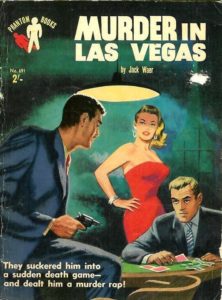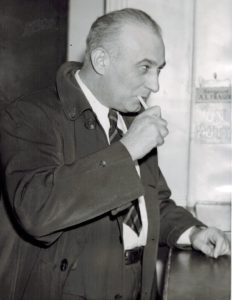by James Scott Bell
@jamesscottbell
 It’s no secret that I love the paperback era of the 1950s. Most of it is eminently entertaining, and almost always well written. Why? Because the writers in those days had been through the classic American schooling that drummed the structure of the English sentence into their heads. Then they paid their dues writing for newspapers, where grizzled editors would scream at them to write more clearly.
It’s no secret that I love the paperback era of the 1950s. Most of it is eminently entertaining, and almost always well written. Why? Because the writers in those days had been through the classic American schooling that drummed the structure of the English sentence into their heads. Then they paid their dues writing for newspapers, where grizzled editors would scream at them to write more clearly.
The result was sharp and grammatical prose, unlike so much of what’s produced today, even in once respected newspapers. I recently saw the word anyways in an actual news column trying to make an actual point.
But I digress.
I recently purchased The Noir Novel Megapack—four 1950s novels for only 55¢! A few days ago I started reading one of them: Murder in Las Vegas by Jack Waer.
It’s terrific. A solid noir set up: After a night of drinking and getting into a fight, a guy wakes up in his apartment, not knowing how he got there. He finds his .38 on the floor and picks it up. Then he spots a dead body on his bed just as his cleaning lady comes in and, seeing the gun in his hand and the body on the bed, screams and runs out. It isn’t long before he’s on the lam and hiding out in L.A.
Excellent hardboiled prose, as in:
His fist came up into my face and it was like having a stick of dynamite exploding inside my head. That was the end of the line. After that there was nothing but the black velvet road that led me through insane dreams.
***
Slowly, I crossed around the bed. I went just so far, then stopped, although the thing inside my gut sprang forward, clawing and spitting. I wanted to yell, to scream out all the filthy things I’d ever learned in all those years on the way up. I wanted to yell until the noise drove away the sight in front of me.
Somebody had been at her throat with a knife.
***
I grabbed the threadbare huck towel off the rack and splashed some water on my face. After I’d dried off I took a look at myself in the mirror and decided never to do it again.
***
The Vanguard was the address where the high tone and six-figure sports kept their private doxies in the manner to which their wives had never been accustomed.
***
The place reminded me of my happy childhood. It was like Old Home Week to enter the dark interior and smell the sweetish odor of stale beer, dampness and despair.
So I found myself wondering, who was Jack Waer? But my initial searches hit a cul-de-sac.
On Amazon, there are only three titles listed for him, as used paperbacks. Murder in Las Vegas, Sweet and Low-Down and 17 and Black.
Who was this guy? I didn’t find any biography of him on the usual noir sites. He was not listed in my go-to reference on this era, Paperback Confidential: Crime Writers of the Paperback Era. I even emailed an MWA Grand Master who is an expert in the pulps. He’d never heard of the guy.
I began to formulate a theory. Because the writing in Murder in Las Vegas is so sharp and spot-on, I thought “Jack Waer” might be a pseudonym for a mainstream novelist. In those days, literary writers often went “slumming” in paperback originals in order to make some dough on the side, all while protecting their “good name.” Evan Hunter did that under the pseudonym Ed McBain. It was McBain who became rich and famous. I don’t know if Hunter ever forgave his alter ego for that.
So that was my theory. Only three books. (It turns out it’s only two, for Sweet and Low-Down is a reissue of 17 and Black with a new title.)
Did he die? Or did the literary author simply move on?
It turns out I could not have been further off.
I did another search on Google and saw an old black and white photo:
So I went to the page, which turned out to be the blog of L.A. mystery writer J. H. Graham. Ms. Graham is, like me, third-generation Angeleno, and we both love the crime lore of the 50s. I am indebted to her for solving the Jack Waer mystery.
Turns out Waer was a gambler running in the same circles as Mickey Cohen, the underworld king of Los Angeles. Says Graham:
Waer, who is also used the name Alexander John Warchiwker according to his naturalization forms, was born in Warsaw Poland in February 1896. He came to Los Angeles sometime after 1930, having previously lived in Detroit. In 1942 he listed Eddie Nealis as his employer on his WWII draft registration card; his job description was not specified. However, he was arrested on gambling charges in July 1943, when D.A. investigators raided an office in the Lissner Building at 524 S. Spring St. and found Waer running a dice game.
The [Los Angeles] Times had called Waer a writer after the NYE 1945 hold-up. He may well have been one; In any case, he became a writer for sure by 1954 with publication of his novel 17 and Black (later issued in paperback as Sweet and Lowdown).
So there you have it. A habitué of the illegal gambling dens of 1950s Los Angeles wrote a couple of books on the side, one of which is pretty doggone good!
Even if your beat is the underbelly of society, it helps if you can write.
Waer, according to Graham. died in Las Vegas in 1966.
And if you are interested in crime fiction that takes place in Los Angeles back in those days, check out J. H. Graham’s mysteries.
What obscure writers have you come across who should be better remembered?


There truly is nothing new under the sun. Waer’s setup in Murder in Las Vegas (I’ve never read it) sounds very much like the setup in my more contemporary short novel, The Unfortunate Case of His Mothers Virginity.
The first paragraph of the promo reads
You wake up after a long nap. You reach over to see whether your partner’s awake, and discover she’s dead. Of a cut throat. In your bed.
Great post, Mr. Bell.
Yeah, the waking-up-with-a-corpse trope was a staple of pulp fiction, almost as popular as waking up with amnesia.
Still works. It’s all in how you handle it!
I tried it for a novella and ended up tossing it. It was too derivative. But as you say, a chestnut can still be good if you can do something new with the recipe. Thanks for the trip to pulp-ville.
Yeah, depending on who you ask, there are 36 plots, or 20, or 3. The difference is US.
Good sleuthing, JSB. I grew up in LA, but in the 50s, I was reading my kid brother’s Hardy Boys books rather than noir paperbacks.
My dad was an L.A. lawyer, living through a lot of the Dragnet stuff that happened. He even ran across Mickey Cohen a few times.
I read a great number of British author, John Creasey’s novels when I was young. He wrote over 600 crime and Sci Fi novels using 28 different pseudonyms. Two of his notable series was The Tof and George Gideon of Scotland Yard. Then, you may already be acquainted.
That’s a great mention, Cecilia! I’m pretty sure I read a Creasey novel years ago (one of his 600!) but can’t recall which one … I’ll have to revisit. Thanks!
I’m listening to the Great Courses book entitled “The Secrets of Great Mystery and Suspense Fiction” and I’m gaining an appreciation for the writers that went ahead of all of us to shape reader expectations. It’s a fascinating read and I wish I had been offered such a literature course in college.
I’m so glad you mentioned the Great Courses, Alec. I’ve gone through many of their courses, my fave being Dr. Rufus Fears on Churchill.
They have a free daily page for the intellectually curious:
https://www.thegreatcoursesdaily.com/
I’m a huge fan of the Paul Pine mysteries by Howard Browne. Haffner Press put out a complete compilation of all the Paul Pine mysteries in one volume not long ago (ISBN 978-1893887695) that I forked out a hefty $54 for, and am thoroughly in love with it. It’s my go-to for noir, or when I’m seeking a feel for my own mysteries.
Yes, another great mention! I’ve read one of the Paul Pines (written under the pseudonym John Evans, and really enjoyed it. Chandler-esque!
Well, if we’re talking writers and not necessarily novelists, then I regret Jack Webb and his script writers leaving us.
Who can forget? “This is the City–Los Angeles California. I work here. I’m a cop. It was hot in Los Angeles. It was Tuesday, August Ninth. We were working a day watch out of day watch out of homicide division. My partner’s Frank Smith . . . ”
Joe Friday was the master of clipped, terse sentences long before there was ever a Ziva David.
The writing laid the visuals and radio descriptions for us in which the pulp novelists plied their stories. We knew the places in our minds: Sawtelle Boulevard, Griffith Observatory, Farmers Market, UCLA, the Coliseum, Wilshire, Hollywood Boulevard, Beverly Hills.
Radio Dragnet was the stuff of Art Deco and, of course, Dom-duh-DOM-dom. Loved it. Miss it. Sigh. THAT Los Angeles still comes to mind. It was a place where you could disarm a suitcase bomb by soaking it in a barrel of water, get coffee in a white paper container that didn’t have advertising, and children said, “Please, Mister,” and, if a movie was made, you knew that Hollywood, not Canada, was involved.
If you can somehow bring it back, I believe a bunch of us would appreciate it.
Ah, the great Jack Webb! And before there was Joe Friday, there was Pat Novak For Hire. You want a great hardboiled blast from the past? Check out Pat Novak!
https://tinyurl.com/ybfeq7zx
Dragnet — couldn’t forget that show. For years, it allowed the LAPD to be fixed in the public mind as brave and fearless and incorruptible — until the Rodney King riots changed everything. But it was classic noir TV. Can I say that?
Absolutely. In the old 1950s version, Joe Friday wore a fedora. In the 60s reboot, he didn’t … and crime was worse. Obviously, to restore order in society, men should wear hats again.
Just bought this. Thanks for the pointer, Jim! 🙂
Enjoy!
Those were great lines with great images. You just cost me 55 cents.
But good ROI …
Please post more.
Every Sunday!